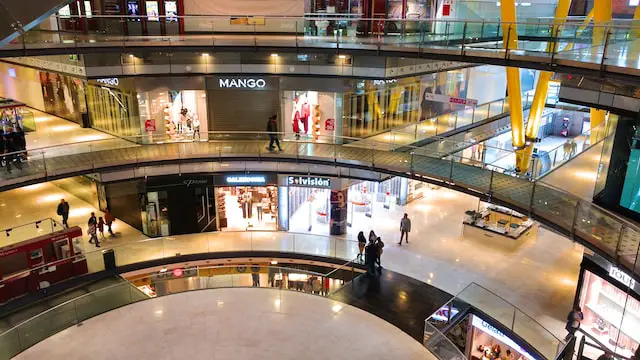The hustle and bustle of a mall represents money being spent and items being purchased.
But how do malls make money to keep the lights on? There are several things to consider in the moving pieces of a shopping mall, all of which are planned around making an overall profit for the stores as well as the mall.
Location and size of the shopping mall also impact the revenue potential.
Whether you’re visiting the mall for a new pair of shoes, a movie, or a haircut, your purchases matter to the overall profit. Read on to take a look at how malls make money.
How Do Malls Make Money?
Here are 5 ways in which malls generate revenue:
- Lease Income
- Sales Proceeds
- Food Court and Restaurants
- Events
- Advertising
Let’s look at each of these revenue sources for a mall.
#1. Lease Income
Any store that moves into a mall must pay rent in order to keep its spot. Most lease agreements in a mall are long-term, typically five years.
Depending on the class, size, and type of the store, the rent will be higher or lower, making department stores much more profitable in lease income than small shoe or jewelry stores or even boutique stores.
When planning a mall, owners and investors are likely to look for the most profitable and popular stores to include in their mall planning, in order to charge higher rent and guarantee long-term lease income.
#2. Sales Proceeds
Another reason that having high-earning stores in a mall is profitable for owners and investors is because of sales proceeds. Typically, there is an agreed-upon threshold for the retail sales of a tenant in a mall that once that sales number has been hit, a percentage of the sales is distributed to investors.
So, a high-traffic store that turns a large profit is guaranteed to hit the agreed-upon threshold, ensuring that the mall makes money in return.
#3. Food and Refreshments
Restaurants and food court vendors pay rent in the same way that other tenants in a mall do. Aside from lease income from these food sources, they also attract more customers to the mall, whether they are stopping in for a bite or planning to stop for lunch during a shopping extravaganza.
Featuring a wide variety of food options encourages people to visit the mall, knowing they can fuel up on whatever they are craving. This helps to bring in overall revenue to the shopping mall.
#4. Events
Holding events in a shopping mall creates additional foot traffic from more consumers, bringing in more revenue for vendors and the mall.
Events like DIY classes, meet-and-greets with an author or celebrity, expert talks, or even pop-up stores are all likely to increase daily earnings in a shopping mall.
Events that are specifically aimed at promoting stores within the mall, or fashion overall, encourage shoppers to attend and then potentially spend money at stores related to the event.
#5. Advertising
Ever notice advertisements throughout the mall? Not only do retail stores advertise to attract customers, but malls feature sponsored advertising through the mall for specific products.
Advertisers must pay to feature their ads throughout a mall, creating a passive stream of revenue that lends to the overall aesthetic of the shopping center.
Advertisements can come in the form of kiosks, posters, lighted or digital dioramas, and even floor decor, all of which are placed in high-traffic areas for optimal frequency of viewing.
Conclusion
So how do malls make money? Malls have multiple potential revenue sources at their disposal.
In this article, we reviewed 5 such income sources. The bulk of a mall’s income comes from leasing space to stores. Most lease agreements are long term making these a steady revenue stream for malls.
Malls also make money from sales proceeds, food courts, restaurants and events. Many businesses will hold events at malls and rent out the needed space.
Finally, malls make money on advertising across the mall in the form of kiosks, posters, and lighted displays. These can be a nice passive revenue source for malls.

